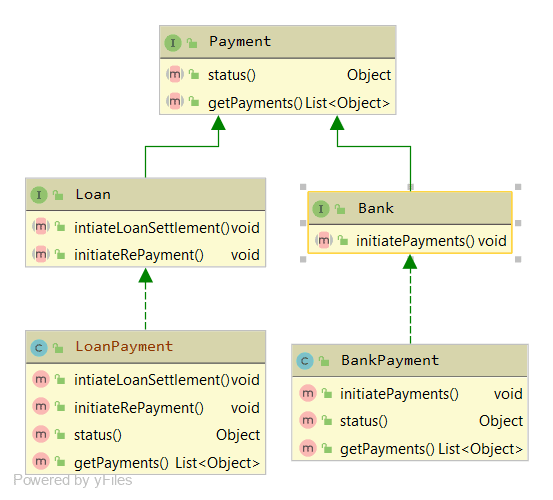1. Introduction
In this tutorial, we’ll be discussing the Interface Segregation Principle, one of the SOLID principles. Representing the “I” in “SOLID”, interface segregation simply means that we should break larger interfaces into smaller ones.
Thus ensuring that implementing classes need not implement unwanted methods.
2. Interface Segregation Principle
This principle was first defined by Robert C. Martin as: “Clients should not be forced to depend upon interfaces that they do not use“.
The goal of this principle is to reduce the side effects of using larger interfaces by breaking application interfaces into smaller ones. It’s similar to the Single Responsibility Principle, where each class or interface serves a single purpose.
Precise application design and correct abstraction is the key behind the Interface Segregation Principle. Though it’ll take more time and effort in the design phase of an application and might increase the code complexity, in the end, we get a flexible code.
We’ll look into some examples in the later sections where we have a violation of the principle, and then we’ll fix the problem by applying the principle correctly.
3. Sample Interface and Implementation
Let’s look into a situation where we’ve got a Payment interface used by an implementation BankPayment:
public interface Payment {
void initiatePayments();
Object status();
List<Object> getPayments();
}
And the implementation:
public class BankPayment implements Payment {
@Override
public void initiatePayments() {
// ...
}
@Override
public Object status() {
// ...
}
@Override
public List<Object> getPayments() {
// ...
}
}
For simplicity, let’s ignore the actual business implementation of these methods.
This is very clear — so far, the implementing class BankPayment needs all the methods in the Payment interface. Thus, it doesn’t violate the principle.
4. Polluting the Interface
Now, as we move ahead in time, and more features come in, there’s a need to add a LoanPayment service. This service is also a kind of Payment but has a few more operations.
To develop this new feature, we’ll add the new methods to the Payment interface:
public interface Payment {
// original methods
...
void intiateLoanSettlement();
void initiateRePayment();
}
Next, we’ll have the LoanPayment implementation:
public class LoanPayment implements Payment {
@Override
public void initiatePayments() {
throw new UnsupportedOperationException("This is not a bank payment");
}
@Override
public Object status() {
// ...
}
@Override
public List<Object> getPayments() {
// ...
}
@Override
public void intiateLoanSettlement() {
// ...
}
@Override
public void initiateRePayment() {
// ...
}
}
Now, since the Payment interface has changed and more methods were added, all the implementing classes now have to implement the new methods. The problem is, implementing them is unwanted and could lead to many side effects. Here, the LoanPayment implementation class has to implement the initiatePayments() without any actual need for this. And so, the principle is violated.
So, what happens to our BankPayment class:
public class BankPayment implements Payment {
@Override
public void initiatePayments() {
// ...
}
@Override
public Object status() {
// ...
}
@Override
public List<Object> getPayments() {
// ...
}
@Override
public void intiateLoanSettlement() {
throw new UnsupportedOperationException("This is not a loan payment");
}
@Override
public void initiateRePayment() {
throw new UnsupportedOperationException("This is not a loan payment");
}
}
Note that the BankPayment implementation now has implemented the new methods. And since it does not need them and has no logic for them, it’s just throwing an UnsupportedOperationException. This is where we start violating the principle.
In the next section, we’ll see how we can solve this problem.
5. Applying the Principle
In the last section, we have intentionally polluted the interface and violated the principle. In this section, we’ll look into how to add the new feature for loan payment without violating the principle.
Let’s break down the interface for each payment type. The current situation:

Notice in the class diagram, and referring to the interfaces in the earlier section, that the status() and getPayments() methods are required in both the implementations. On the other hand, initiatePayments() is only required in BankPayment, and the initiateLoanSettlement() and initiateRePayment() methods are only for the LoanPayment.
With that sorted, let’s break up the interfaces and apply the Interface Segregation Principle. Thus, we now have a common interface:
public interface Payment {
Object status();
List<Object> getPayments();
}
And two more interfaces for the two types of payments:
public interface Bank extends Payment {
void initiatePayments();
}
public interface Loan extends Payment {
void intiateLoanSettlement();
void initiateRePayment();
}
And the respective implementations, starting with BankPayment:
public class BankPayment implements Bank {
@Override
public void initiatePayments() {
// ...
}
@Override
public Object status() {
// ...
}
@Override
public List<Object> getPayments() {
// ...
}
}
And finally, our revised LoanPayment implementation:
public class LoanPayment implements Loan {
@Override
public void intiateLoanSettlement() {
// ...
}
@Override
public void initiateRePayment() {
// ...
}
@Override
public Object status() {
// ...
}
@Override
public List<Object> getPayments() {
// ...
}
}
Now, let’s review the new class diagram:

As we can see, the interfaces don’t violate the principle. The implementations don’t have to provide empty methods. This keeps the code clean and reduces the chance of bugs.
6. Conclusion
In this tutorial, we looked at a simple scenario, where we first deviated from following the Interface Segregation Principle and saw the problems this deviation caused. Then we showed how to apply the principle correctly in order to avoid these problems.
In case we’re dealing with polluted legacy interfaces that we cannot modify, the adapter pattern can come in handy.
The Interface Segregation Principle is an important concept while designing and developing applications. Adhering to this principle helps to avoid bloated interfaces with multiple responsibilities. This eventually helps us to follow the Single Responsibility Principle as well.
As always, the code is available over on GitHub.







